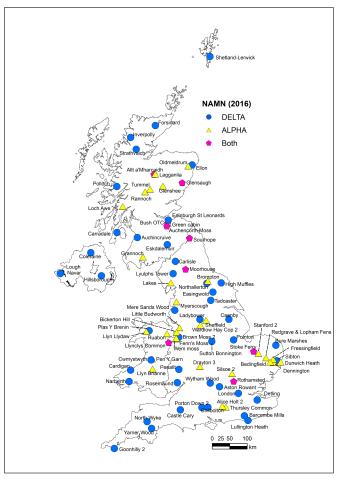The ALPHA data on the National Ammonia Monitoring Network has been reissued for the years 2022 and 2023 due to a change in uptake rate applied. The change in uptake rate leads to an increase in reported concentration from ALPHAs of 21.9 % and 40.6 % for 2022 and 2023 respectively. Please refer to the NAMN for further details.
Ammonia (NH3) emissions are estimated to have at least doubled over the last century across Europe, concomitant with intensification of agriculture, and increase in use of nitrogen fertilizers. The main sources of NH3 in the atmosphere are from the decomposition and volatilisation of animal wastes. Other sources include direct volatilisation from synthetic fertilizers (particularly urea), and a wide range of non-agricultural sources such as sewage, catalytic converters, wild animals and industrial processes. It is recognised that deposition of atmospheric NH3 contributes to acidification and eutrophication processes, which can cause damage to sensitive ecosystems.
Under the UNECE Gothenburg Protocol and the National Emissions Ceilings Directive of the EU, the target of both these agreements is that NH3 emissions should not exceed 297 kt as NH3 by 2010, with a particular focus on reducing the extent of critical loads exceedance for acidification and eutrophication effects. Abatement of NH3 emissions is also included in EU Integrated Pollution Prevention and Control (IPPC) for the intensive pig and poultry sectors.
In the UK, the Department for Environment, Food and Rural Affairs (DEFRA) is supporting work to monitor the air concentrations of gaseous ammonia (NH3) and particulate ammonium (NH4+) in the UK National Ammonia Monitoring Network (NAMN). Established in 1996, the objectives are to quantify temporal and spatial changes in air concentrations and deposition in NH3 and NH4+ (included since 1999) on a long term basis. The monitoring provides a baseline in the reduced nitrogen species (NHx = NH3 + NH4+), which is necessary for examining responses to changes in the agricultural sector and to verify compliance with targets set by international agreements. Data from the network are also used to test the performance of an atmospheric chemistry and transport model, FRAME that was developed at the same time with a special focus on NHx, and to contribute to national Nitrogen (N) deposition estimates.

The National Ammonia Monitoring Network (NAMN) provides gaseous ammonia concentrations (NH3) monthly at 113 sites (94 using UKCEH ALPHA© (Adapted Low-cost High Absorption) passive samplers, 28 sites using UKCEH DELTA© active samplers as of August 2024. A subset of 9 sites has co-located samplers to correct on an annual basis.
The following criteria were used during selection of the monitoring sites:
Representative spatial coverage of the UK.
Representative coverage in relation to predicted ammonia concentrations at a 5 km x 5 km grid level, including key emission 'peaks' and 'trough' areas.
Immediate vicinity of ammonia sources on a local level (avoiding very close proximity to local sources, e.g. animal buildings etc.)
Availability of a willing and helpful local contact.
Co-location of the sites in relation to other air quality and ecosystem monitoring information.
Nature conservation interest of the site, particularly in relation to plant community sensitivity to nitrogen deposition and nature reserve status.
Different areas in the UK emit NH3 from different sources, so that the sites can be used to investigate differences between NH3 patterns according to the dominant NH3 source for an area. Six source types are used to classify differences: background, non-agricultural, mixed agricultural, cattle, pigs & poultry and sheep. Emissions of NH3 are expected to respond to changes in these different sectors, and it therefore becomes possible to look at changes in NH3 in response to sector activity as well as agricultural and environmental policies.